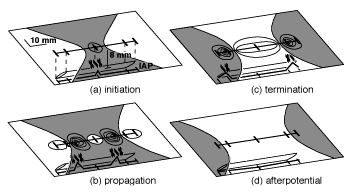
Figure 1. Computer simulation of the electrical field on the surface of the skin during the four stages of a compound muscle action potential.
1996 Project Reports | Home | Contents | Previous | Next |
Kevin C. McGill, PhD; Zoia C. Lateva, PhD; Charles G. Burgar, MD
Neurologists and physiatrists routinely record the electrical signals generated by nerves and muscles in order to assess neuromuscular function in patients with suspected neuromuscular disorders. The purpose of this project is to develop ways to analyze these signals that are more objective and diagnostically sensitive. Our approach is to try to extract quantitative information from the signals about the physiological processes that underlie them. We use computer models to understand the way in which the signals are generated and conducted through the body. We also use signal processing techniques to decompose the recorded signals into their fundamental physiologically related components.
Electrophysiological and Anatomical Determinants of Compound Muscle Action Potentials
The compound muscle action potential (CMAP) is the electrical response of a muscle to stimulation of its motor nerve. CMAPs are recorded clinically to assess muscle function in cases of suspected nerve entrapment, demyelinating neuropathy, and neuromuscular junction disease. For example, to test for impairment of nerve function in carpal tunnel syndrome, the CMAP of the thenar muscles of the hand is recorded in response to electrical stimulation of the median nerve at the wrist. Abnormal latency or amplitude of the CMAP is indicative of nerve impairment.
Despite the importance of the CMAP in electrodiagnosis, the precise way in which the CMAP waveform is determined by the electrical activity in the muscle is not completely understood. To investigate this question, we analyzed thenar CMAPs from ten normal subjects in the light of computer simulations. Our results show that the surface electrodes utilized to record the thenar CMAP are able to detect the electrical process that take place along the entire length of the thenar muscles. Consequently, the CMAP can be divided into four distinct parts, each of which corresponds to a separate stage in the electrical activity in the muscle (Fig. 1). The rising edge corresponds to the initiation of the action potential at the neuromuscular junction, the negative phase corresponds to the propagation of the action potential along the muscle fibers, the positive phase corresponds to the termination of the action potential at the muscle/tendon junctions, and the positive tail corresponds to the slow second phase of repolarization. We hope a fuller understanding of the way in which the electrical events within the muscle manifest themselves in the CMAP will make it possible to extract additional clinically important information from the CMAP.
 Figure 1. Computer simulation of the electrical field on the surface of the skin during the four stages of a compound muscle action potential. |
Quantitation of the Electromyogram
The electromyogram (EMG) is the electrcal signal recorded by needle or surface electrodes during a voluntary muscular contraction. Interpretation of the EMG is an important part of the clinical neurophysiological evaluation of patients with suspected disorders of either nerve or muscle. At present there are two main quantitative approaches to analyzing clinical EMGs. Motor-unit analysis characterizes the signal in terms of the properties of the individual motor-unit action potentials (MUAPs) that make it up. Interference-pattern (IP) analysis characterizes the EMG signal in terms of statistical measures of its amplitude and complexity. Motor-unit analysis is more widely accepted, since it is more closely related to the underlying motor-unit physiology. However, it is restricted to low- and moderate-force contractions because of the complexity of identifying individual MUAPs in forceful contractions.
Republished from the 1996 Rehabilitation R&D Center Progress Report. For current information about this project, contact: Kevin C. McGill